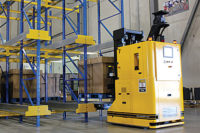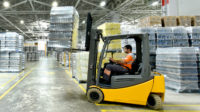Operations
Sustainable buildings, features boost operation’s efficiency
Government incentives, outdated systems prompt interest in sustainable facilities

Image courtesy of Getty Images
After saving her cousin Bruce Banner (the Hulk) following a car crash, Jennifer Walters went from your typical district attorney to a reluctant superhuman lawyer thanks to her cross-contaminating with Banner’s blood in the new Disney+ show “She-Hulk: Attorney at Law.” Nicknamed She-Hulk, Walters is navigating her new world defending cases for superhumans, including those who threatened her cousin.
In the real world, when it comes to making the “business case” for sustainable manufacturing, experts note that sustainable facilities can increase an operation’s efficiency by reducing costs and waste.
Before embarking on a sustainable facility journey, Patrick Holleran, vice president at St. Louis-based HDA Architects, notes that operations should consider the overall return on investment (ROI).
“Most if not all of our customers are interested in a sustainable warehouse facility, however, they are interested for different reasons,” he says. “They are either looking to cut utility costs, build a sustainable building to help the environment, or both. With increasing construction and material costs, sustainable design can assist with their ROI through energy efficiency.

Image courtesy of HDA Architects
“It’s no different than any business decision,” Holleran continues. “I would recommend that an operations manager start with ‘why’ they are looking to build a sustainable facility and then discuss that desire with the design team that they have partnered with to ensure that all options are analyzed for the project.”
According to the Environmental Protection Agency (EPA), a large and growing number of manufacturers are realizing substantial financial and environmental benefits from sustainable business practices.
On its government website, the EPA lists a number of reasons as to why companies are pursuing sustainable manufacturing, including the following:
- To protect and strengthen its brand and reputation, and to build public trust
- To build long-term business viability and success
- To respond to regulatory constraints and opportunities
Government initiatives, incentives
As regulations can influence the pursuit of sustainable features in a beverage facility, experts note that many state and local governments offer incentives or programs to reward those implementing sustainable practices.
“Energy costs and stricter code requirements often influence the desire to pursue sustainable features,” HDA's Holleran says. “The gap between ‘sustainable’ and typical design is much tighter than before, which makes any additional costs minimal while maintaining additional operational savings.”
Beam Suntory, Chicago, is set to invest more than $400 million to expand production at its Booker Noe distillery in Boston, Ky., which produces Jim Beam. Beam Suntory entered into an agreement with 3 Rivers Energy Partners to build a facility across the street to convert spent stillage into biogas, which will be treated to renewable natural gas standards and piped directly back to the Booker Noe facility.
Upon project completion, which is expected in 2024, the Booker Noe distillery will be 65% powered by renewable natural gas, and 35% by fossil-based natural gas, according to the company.
Beam Suntory’s investment was first announced by the state of Kentucky through a series of economic incentive grants, made in July, including the $400 million investment to increase capacity, build warehouses, and create new jobs.

Image courtesy of HDA Architects
3 Rivers Energy Partners specializes in the design, build, and operations of renewable natural gas projects. The company works to provide renewable energy solutions for organizations by utilizing existing bio-waste streams as feedstock for renewable energy sources.
“Our goal is to help Jim Beam create a sustainable future for their company and the planet,” said John Rivers, CEO of 3 Rivers Energy Partners, in a statement. “With this process, we will create new renewable energy, and help sustain the agriculture needed to create their products. It is truly a full circle sustainability approach.”
Offsetting energy costs, equipment efficiency
Where many state and local governments have programs for implementing sustainable practices, experts note that some incentives offset upfront costs, while others are distributed over a number of years.
For beverage warehouses, some of the most popular sustainability initiatives include solar arrays, LED lighting and lighting control systems, HDA's Holleran says.
“The solar incentives that continue to be offered both federally and locally have made solar arrays a viable option for our customers,” he explains. “Due to the large roof area, we’ve found solar to be a viable option for many locations.”
New energy conservation codes also are affecting local, state and federal incentives, Holleran notes.
“One major trend that probably isn’t on most people’s radar is the phasing out of popular refrigerants. Synthetic refrigerants have a detrimental impact on the atmosphere and there isn’t a whole lot of clarity on the future of synthetic refrigerants,” he explains. “Refrigerants that were popular as recently as five years ago are being phased out, which means manufacturers are designing equipment around new refrigerants that could see the same phase out in the very near future.
“The impact of this is that replacement parts on a failing piece of equipment could be cost prohibitive if they are even available in some cases,” he continues. “Refrigerants are not a one size fits all answer, it’s important to engage an experienced engineer to help guide the owner to the right choice.”
Further, as equipment efficiency has improved during the past 10 to 15 years, Holleran notes that if equipment is 10 years old or more, the cost of maintenance or replacement is only going to increase.
“It may be an effective strategy to engage a mechanical engineer to evaluate replacement versus a system upgrade,” Holleran says. “Mechanically, the incentive is in the ROI.
“Another option to consider is an effective control system that monitors the operation of the equipment and verifies that the equipment isn’t running more than it has to,” he continues. “These control systems can stage equipment on and off to limit demand charges in areas where demand cost is very high. It’s important that these systems offer feedback and reporting to allow the owner to see how their system is operating.”
Moreover, as many municipalities have storm water management standards, which implement sustainable design, Holleran notes that the building envelope construction continues to evolve and improve energy efficiency.
“Continuous insulation and use of concrete, which contains recycled content, provides an efficient and long-term building while limiting waste,” he explains. “Due to the expansive paved area required for warehousing, concrete has become a preferred paving material and reduces demand for petroleum based materials.”
Design team is key
As there’s a sizeable appetite for sustainability in warehouse facilities, experts note that warehouse managers can utilize an experienced design team to help analyze the ROI models for each sustainability option.
Holleran suggests contacting industry leaders to discuss which systems affect operations — upfront costs, maintenance costs, etc.
“Determine your end goal, how much of an impact to the environment are you looking to reduce?” Holleran says. “Are you looking to capture the low hanging fruit or do you have a desire to find ways to leave a lasting impact for future generations? Finding the right experienced design team is important to help flush out these answers.”
Moreover, a qualified design team can offer options with cost and energy saving calculations to help determine the best course of action, he explains.
“Sustainability is best achieved when all disciplines are working together, what the architect is doing could have a great impact on what the electrical engineer can or can’t do, which then affects the options available to the mechanical engineer,” he says. “A qualified team will interact with each other and explore options that are best for the overall project.”
Looking for a reprint of this article?
From high-res PDFs to custom plaques, order your copy today!






